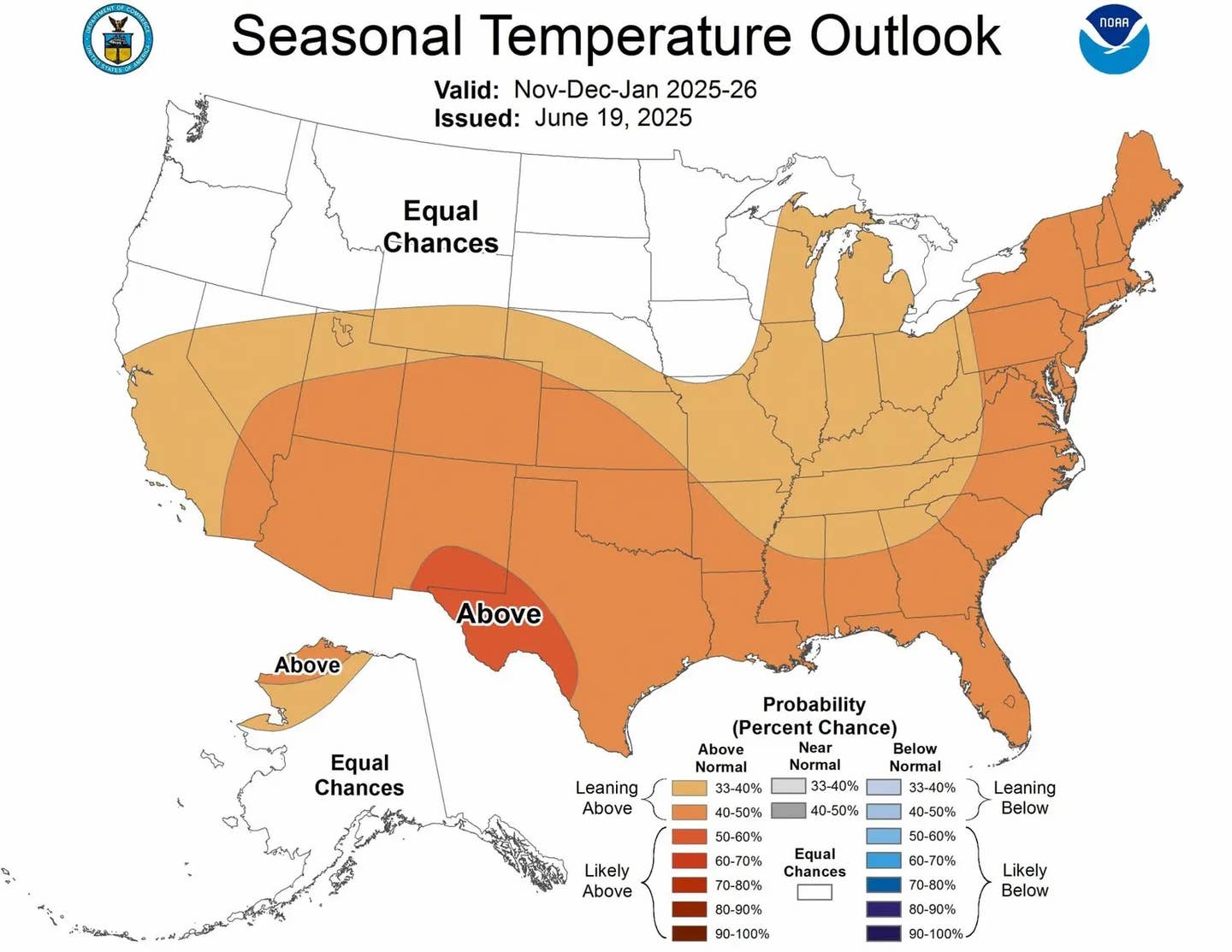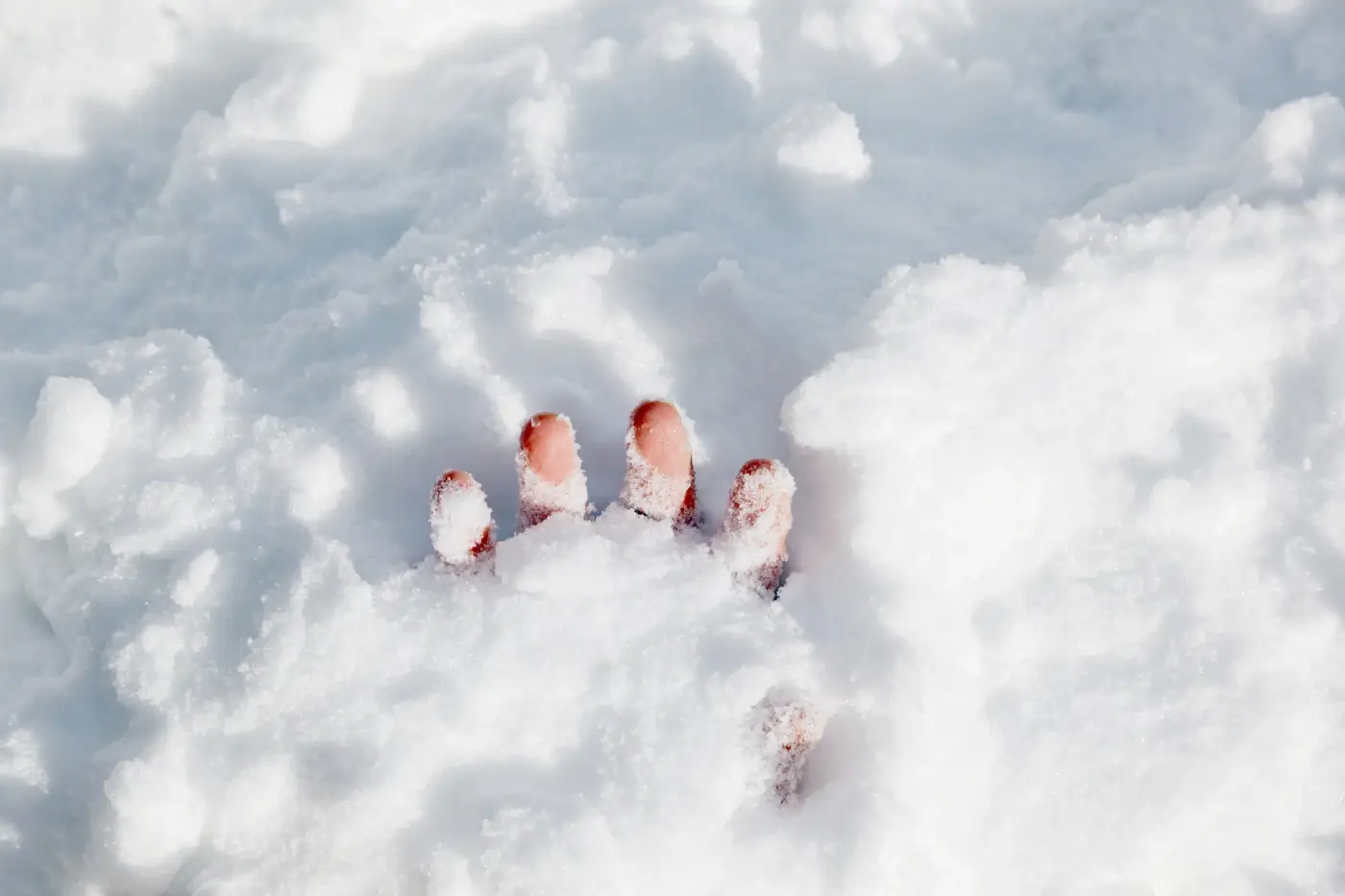Popular Stories
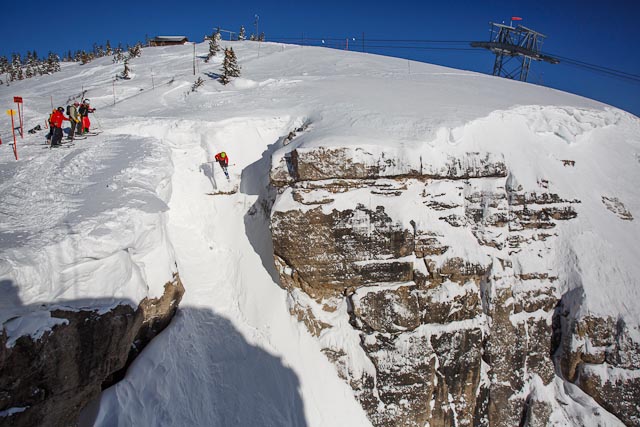 Dropping into one of the world's most infamous runs: Jackson Hole's Corbet's Couloir. Eric Seymour/JHMR photo.
Dropping into one of the world's most infamous runs: Jackson Hole's Corbet's Couloir. Eric Seymour/JHMR photo.
There is an iconic Jackson Hole poster of a skier airing down a steep slope, with the caption,
“College degree. Good job. Big house. We all make
mistakes.”
And so it may be only be fitting that
Corbet’s Couloir–
Jackson Hole’s most famed, coveted, and sought-after run–is
named after a 1950’s college dropout, who headed west to Wyoming to pursue ambitious
dreams in the mountains.
In 1960, Paul Mcollister, then-president
of the Jackson Hole Ski Club (and one of the founders of
Jackson Hole Mountain Resort), was researching
Rendezvous Peak as a possible ski resort site when he climbed and skied the
mountain with fellow local resident Barry Corbet, a Canadian-born, Dartmouth College
student who had dropped out of school and moved to Jackson to be a skier and mountaineer,
and to work for
Exum Mountain Guides. As
they ascended to where the top tram dock is today, Corbet is said to have pointed
out a rock and cornice-crowned, 40-degree slice of snow in the north-facing
cliffs of the peak and predicted, “Some day, that will be a ski run.”
The two didn’t ski it that day, but the
line bore his name from then on, quickly becoming known as Corbet’s Couloir. Ski
patrolman Lonnie Ball is credited with the first drop in on skis in 1967, and Corbet
is said to have eventually skied his namesake run, adding to his impressive
list of climbing and mountaineering accomplishments. Corbet made first ascents
around the world, including Denali’s Southwest Rib, and was a member of the
first American team to summit Everest in1963 - although Corbet himself did not
summit.
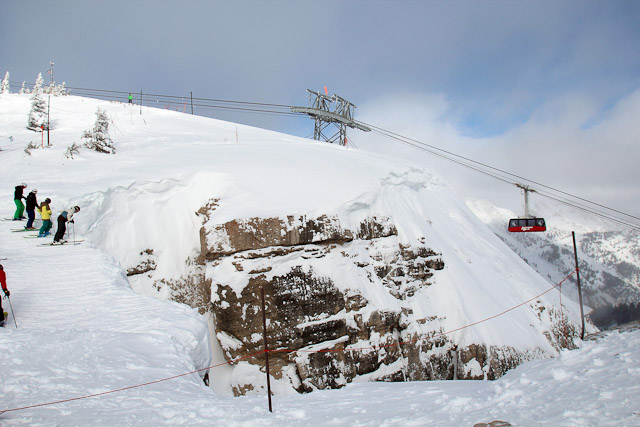 Sitting in plain view of the Jackson Hole Tram, Corbet's offers big-mountain showboating like no other line on the mountain. Patrick Nelson/JHMR photo.
Sitting in plain view of the Jackson Hole Tram, Corbet's offers big-mountain showboating like no other line on the mountain. Patrick Nelson/JHMR photo.
Nonetheless, for decades, the couloir
was seldom skied. “In the 1960’s and ‘70s, that was a different world,” says
Bob Comey, a Jackson Hole ski patroller and avalanche forecaster. “The run was
never prohibited, but no one really considered going there. And the sport has
evolved a lot, but it is still one of the most challenging runs on the
mountain.”
Today, Corbet’s has been skied by
countless women, men, small (local) children, adaptive skiers (Chris
Devlin-Young nailed the
first
sit-ski descent
in 2011) and even dogs have been known to make
the leap
– and stick the landing. When Corbet’s is open, people line up in
droves at the entrance to peek in. But none of the hype means any skier should
take the run lightly: it’s a seriously consequential, high-speed drop onto a 45
degree slope that requires good conditions and multiple powerful, technical
moves on skis or a snowboard to successfully execute.
Why Corbet's Is So Famous, and So Gnarly
Future TGR film athlete Max Hammer pulled off a wild feat in the spring of 2013–skiing non-stop from the top of the Tram, including a full-speed launch into Corbet's, for TGR inaugural Co-Lab contest.
The word
couloir translates from the French roughly as a hallway or passage.
Steep rock walls form three sides of Corbet’s, and a well-known, fear-striking cornice
forms along the entry. For that, skiers can thank the fact that the cliffs face
northeast, and the prevailing winds in Jackson often come from the southwest.
The snow blows across Rendezvous Bowl and swirls down into Corbet’s, creating
the cornice - but also depositing snow in the couloir itself, making the run
soft for at least, well, the first ten skiers to hit it.
Ski patrol will open the couloir each
season when there’s enough snow to cover the refrigerator-sized boulders in the
chute and rocks in the entrance. That’s generally when there’s about a 50 to 70
inch base.
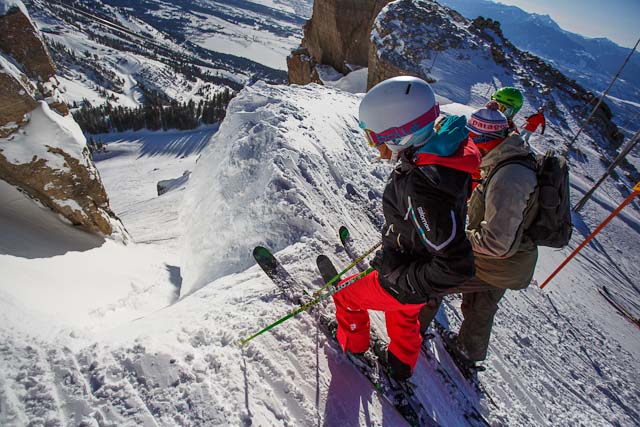 While the main cornice bulges out over the middle out of the couloir, the skier's left side, known as "the goat path," is where most first-timers drop in. Eric Seymour/JHMR photo.
While the main cornice bulges out over the middle out of the couloir, the skier's left side, known as "the goat path," is where most first-timers drop in. Eric Seymour/JHMR photo.
The cornice formation every season
makes the skier’s left hand side the easiest way to get in. If you want to
avoid the technical moves that requires, you can send it straight off the center
of the cornice and put yourself nicely in the center chute – at a seriously
high rate of speed provided you stick the 25 to 30-foot drop. The right side
offers numerous creative options, but unless it is deep snow year, your airtime,
necessary technical skills, and commitment will only need to expand to survive.
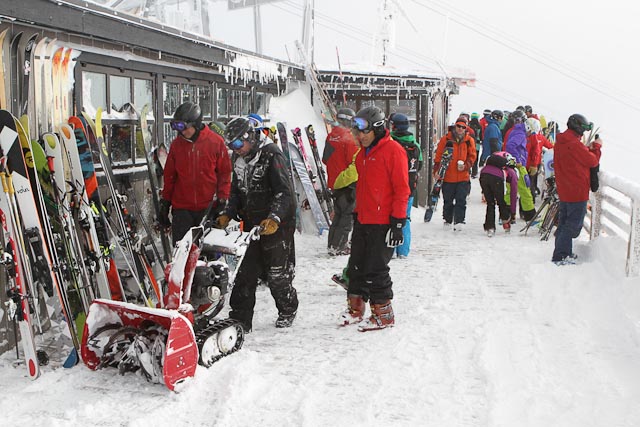 Corbet's Cabin is where you'll want to eat a waffle, and likely take a nervous pee, before riding the short distance down to Corbet's Couloir. Ryan Dunfee photo.
Corbet's Cabin is where you'll want to eat a waffle, and likely take a nervous pee, before riding the short distance down to Corbet's Couloir. Ryan Dunfee photo.
Ski patrol will close the run if
looks as if people are going to start going to the hospital (i.e., it gets too
icy or the rocks in the landing appear from all the scraping skis) but before
that spectacular level of sub-optimal conditions – it is up to the skier or
rider’s discretion. “People show up to ski here and it’s on their list, but if
conditions aren’t good, be prepared to say no and ski away,” advises Comey.
For those who show up at the right
time on the right day, however, there are multiple levels of rewards, and an
awesome ski run that you’ll remember for a lifetime. As a protected, north-facing
run, if it isn’t powder, the snow is generally at least chalky, and lies on a
fun, 40 degree pitch once you’re in there. The aesthetic satisfaction of
descending a chute between steep rock walls is unforgettable, with a wonderful
feeling of freedom as you arc turns onto the apron of Tensleep Bowl below.
How To Ski Corbet's
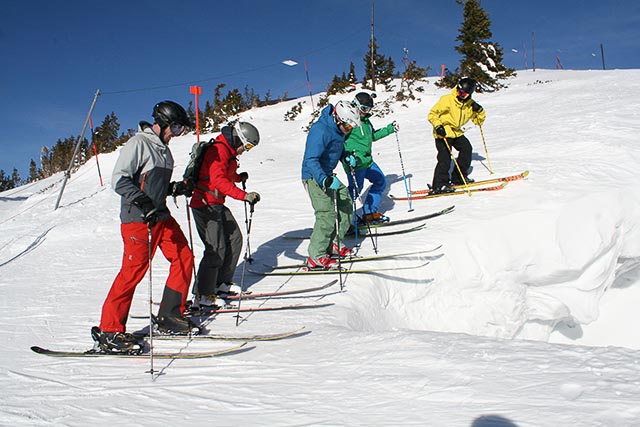 A group sizes up the main entrance to Corbet's. You'll find a friendly atmosphere of people conquering their fears, or admitting they're not up for the task and cheering on those who are. Ryan Dunfee photo.
A group sizes up the main entrance to Corbet's. You'll find a friendly atmosphere of people conquering their fears, or admitting they're not up for the task and cheering on those who are. Ryan Dunfee photo.
Experienced skiers and riders who
have gone in many times still view Corbet’s as an ongoing mental game. Myriad
factors set the butterflies in your stomach on a rampage: the tram cruising by,
spectators lined up staring, wafflers who shuffle their skis at the top,
peering over the edge for long, anxious minutes, and changing conditions and
consequences below. But despite – or maybe because - of all that, the edge of
Corbet’s is a place of camaraderie, supportive cheers, good vibes and personal
achievements.
In March of 2012, TGR brought a grip of top skiers to shred Corbet's for the film The Dream Factory. It marked one of the all-time sessions to go down in the infamous couloir.
The sense of joining all the legends
who have skied the line is palpable – from recent groms in TGR ski movies to
icons like Doug Coombs, to local legends, like former ski patroller Joe Larrow,
who made history in 1979 with a jaw-dropping, massive air. Larrow tucked from
the top of the tram and sent it straight into the chute, landing about a third
of the way down and probably eighty feet out.
Join Our Newsletter
Yet if you find yourself stuck on the
edge, a paralytic sense of dread spreading throughout your body, you may not be
ready to commit just yet. “There’s always a butterfly factor,” says Jess
McMillan, a professional freeskier who grew up skiing Jackson and Corbet’s.
“But you are not feeling it 100%, you shouldn’t ski it,” she says.
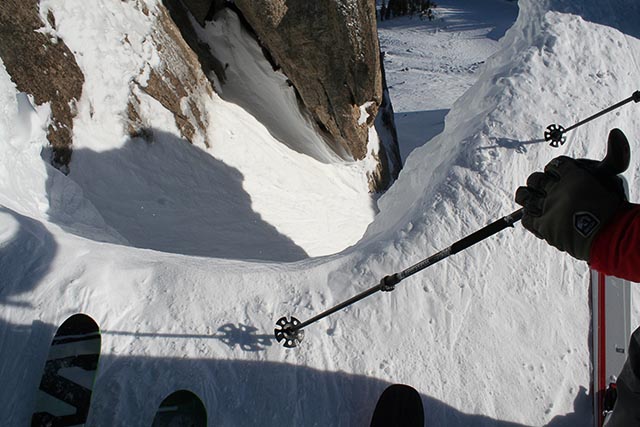 Is the entrance looking bony, refrozen, and rock solid like in this picture? Back away, young Jedi... Ryan Dunfee photo.
Is the entrance looking bony, refrozen, and rock solid like in this picture? Back away, young Jedi... Ryan Dunfee photo.
McMillan reminds people to resist the
urge to ski it on their vacation if it is in poor conditions. “It’s rowdy. I
only ski it when it’s in good conditions,” she said. “It’s supposed to be fun,
after all. And you want to look pro – you never want to sidestep in, or slide
down, or tomahawk – unless it’s really spectacular and you tomahawk all the way
down.”
“The ideal day to go into it is a waist-deep
day,” says Bob Comey, who compares Corbet’s to a frozen, but ever so slowly-moving
surf break – sometimes the stars align for you, and sometimes, you must come
back another time.
Bryan Iguchi, a professional snowboarder
who has ridden Corbets innumerable times, concurs with how good – or bad – the
line can be. “The most amazing session in there for me was a bluebird powder
day shooting with [fellow pro] Johan Olofsson. We were spinning off the top, it
was incredible. I’ll never forget it,” he says. But even Iguchi still admits
that it’s a tough entry, and he still doesn’t make it every time.
How To Practice for Corbet’s
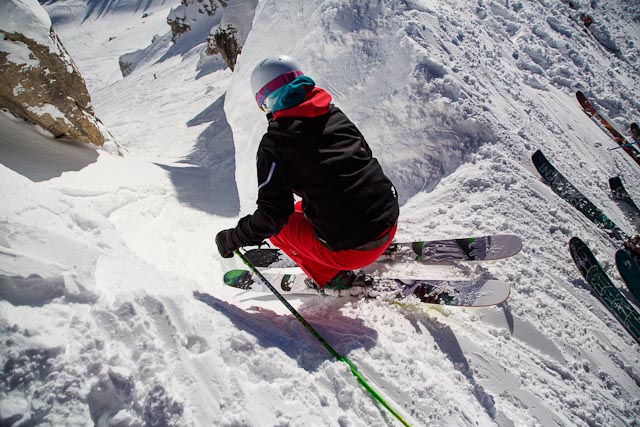 Hannah Hardaway commits and drops into Corbet's via the "goat path." Eric Seymour/JHMR photo.
Hannah Hardaway commits and drops into Corbet's via the "goat path." Eric Seymour/JHMR photo.
If you want to ski Corbet’s
confidently, there is something you can do: practice. Nearly all first-timers
drop in on the skiers left – often referred to as the goat path – where you
face a drop or high-speed straight-line directly at a granite wall. A fast
right-hand, blind turn is required to avoid the wall, followed by another,
nearly instant left hand turn to avoid the right-side wall. A little pre-game
preparation can help take you from petrified anxiety to pure stoke and nailing
the sequence like pro.
Find places on
the mountain where you
can plan a high-speed straight-line into a sharp right turn, making sure to practice
avoiding getting bucked back on your skis or snowboard. That is a super
important factor – if you are not aggressively forward, you are likely to crash
when you try to make the next, immediate left turn into the rest of the chute. Steep
cliffy areas of the mountain like Expert Chutes (below Tensleep Bowl) or Bird in the Hand (off of the Sublette quad), for
example, are good practice spots without the consequences, and will give you a
physical, and certainly mental, advantage. Check out JHMR's full trail map
here.
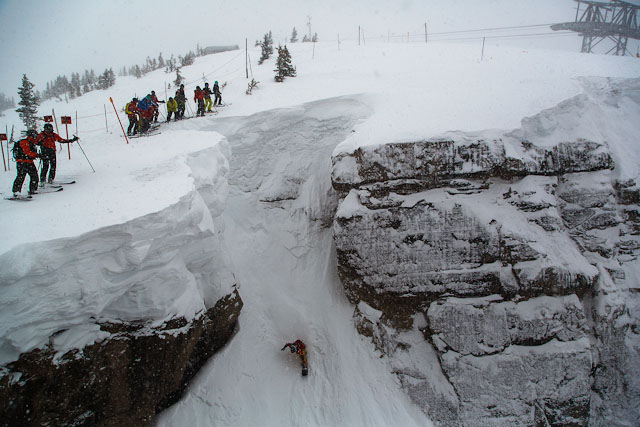 If the person in front of you isn't making a racket as he or she rides the couloir, you'll know the snow is decent and soft after the drop. Eric Seymour/JHMR photo.
If the person in front of you isn't making a racket as he or she rides the couloir, you'll know the snow is decent and soft after the drop. Eric Seymour/JHMR photo.
Next up, inspect the conditions in
the actual couloir. Iguchi suggests watching how it goes for others – after
all, there’s no need to put yourself in danger if others are willing to guinea
pig it for you first. “Take a good look – see how the locals are hitting it, as
it changes throughout the season,” says Iguchi. He also advises listening: If
the snow sounds scratchy and hard, come back another day. “If it’s not loud,
you can start breaking down the moves,” he says. “Get a good look and a feel
for the snow, but when you go, you’ve got to commit wholeheartedly, solid and
confident over your board. And then, there’s probably still a good chance
you’re not going to make it. Once in a while I'll go in and end up getting a
beating,” laughs Iguchi.
Once you finally get in the chute, keep your eyes peeled to left for the legendary Coombs Cave, named for Doug Coombs. Swing in, read the plaque, and let the special feel and respect for the mountains that permeates the chute sink in.
Once you finally get in the chute,
keep your eyes peeled to left for the legendary Coombs Cave, named for Doug
Coombs. Swing in, read the plaque, and let the special feel and respect for the
mountains that permeates the chute sink in. When you pop out of the cave,
you’re home free, arcing big turns in your new incarnation as a Corbet’s skier,
down an open apron into Tensleep Bowl.
Just to the skier's right sits Corbet's even gnarlier cousin–S&S Couloir.
But don’t go getting too big for your
britches just because you finally nailed Corbet’s. For a dose of humble pie, take
a moment to look back up at the local’s favorite: the seldom skied, vastly
gnarlier and narrower couloir to the looker’s left of Corbet’s. Named S&S
Couloir, its initials stand for the first two skiers to drop into it: legendary
former patrollers John Simms (founder of Life-Link and Simms Fishing) and
Charlie Sands (of Jackson’s Sand’s Whitewater), who to this day refuse to say
who went in first.
If you want to put that on your
bucket list, this article won’t help you. You’ll have to quit your job and
become a ski bum in Jackson if you want to get good enough, and bold enough, to
tackle S&S.

